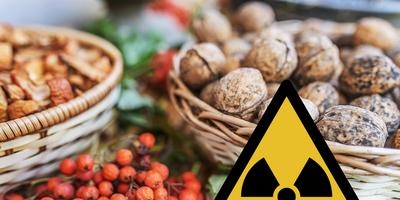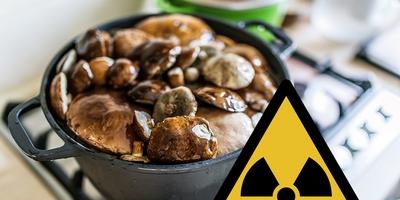|
 A person lives in an environment, the radioactivity of which is caused by both natural and artificial radioactive substances that enter his body in various ways, primarily with food and water. A person lives in an environment, the radioactivity of which is caused by both natural and artificial radioactive substances that enter his body in various ways, primarily with food and water.
The amount of radionuclides (radioactive substances) in the human body depends on their concentration in the external environment. The redistribution of chemical compounds containing radioactive substances in the human environment is very uneven and depends on many reasons, which in turn determine the nature and level of radioactivity of food. These products may contain individual radionuclides, as well as their mixtures, and certain food products of plant and animal origin have different properties to accumulate radioactive compounds, so the concentration of radionuclides in them may even be many times higher than the concentration in the environment.
The level of contamination of food with radionuclides, caused by human activities, depends on the intensity of radioactive fallout, their biological availability, soil and climatic conditions. The uneven deposition of radioactive substances in different territories also determines their uneven intake into food. Peculiarities of the nature of food in different countries of the world, the predominant use of products of plant or animal origin leads to the intake of radionuclides into the human body through different food chains. So, when testing nuclear weapons, the main source of radioactive iodine in the US and European countries was milk, and in Japan - vegetables and fruits. At present, in the USSR, the main source of radioactive strontium intake with food is bread products, in the USA and England - milk, in Japan - vegetables. The source of cesium-137 is baked goods, milk and vegetables. A few percent of strontium-90 and cesium-137 come with water and air. The ways in which radionuclides enter the human body can be simple and complex. The main food chains are: plants - man; plants - animals - milk - people; plants - animals - meat - people; water - aquatic organisms - man, etc. The concentration of radioactive substances in these links of the food paths depends on the physicochemical properties of compounds containing radionuclides, on environmental conditions, the structural features of soils and biological properties of plants and animals.
 The natural (natural) radioactivity of food products is mainly due to tritium-3, beryllium-7, carbon-14, sodium-22, potassium-40, lead-87 and radionuclides of the uranium and thorium families. The relationship between the content of these radioactive substances in food rations, even in higher amounts compared to the world average, and human diseases has not been found. The natural (natural) radioactivity of food products is mainly due to tritium-3, beryllium-7, carbon-14, sodium-22, potassium-40, lead-87 and radionuclides of the uranium and thorium families. The relationship between the content of these radioactive substances in food rations, even in higher amounts compared to the world average, and human diseases has not been found.
Of particular importance as a factor affecting human health can be artificial radioactivity resulting from contamination of the environment and food during emergencies at nuclear installations, radiochemical plants, during the operation of nuclear power plants, during testing of nuclear weapons, in the process of mining, during the operation of power plants on mineral fuel, the use on a large scale in agriculture of various fertilizers extracted from the bowels of the earth and used in vast territories in large quantities.
Radioactive substances enter plant tissues mainly in two ways.Air pollution is deposited on the surface of the ground parts of plants, lingering on it or penetrating into tissues (this path of pollution can have unpleasant consequences for humans only during the growing season). The degree of penetration of radionuclides into tissues in this case will depend on the physicochemical properties of compounds containing radioactive substances. Easily soluble compounds penetrate plant tissues more easily. Soluble substances can be absorbed through leaves, stems, inflorescences, fruits. It has been established that these processes proceed rather slowly, so that most of the pollution is on the surface of plants for a long time, which makes it possible to count on a decrease in the degree of their pollution under the influence of rain.
During rains, impurities are washed off from the top of the plants; which sharply reduces the likelihood of radioactive substances entering through inflorescences and leaves and increases the likelihood of their penetration into plant tissues from the very surface layer of the soil (sod). This fact complicates the use of perennial plants as livestock feed. Under conditions of intense contamination with radioactive substances, the latter can be absorbed from the sod for many months and years, but this process still continues for a shorter time than the intake of radionuclides from the depths of the soil. The actual decrease in soil and plant contamination by them occurs as a result of the natural process of decay of radionuclides. Long-lived radionuclides enter plants in varying amounts. Their entry into plant organs is determined by many interacting factors. In addition to their concentration in the external environment, such factors include the content of other ions in the soil solution, the concentration of stable isotopes of the same radionuclides, the type of soil, and the specific content of organic compounds in them.
Farm animals that find themselves in a contaminated environment, respectively, are accumulators of radionuclides along the chain feed - animal. The channels for the entry of radioactive substances into the body of animals are also the skin and respiratory organs. Anatomical and physiological features of the structure of various farm animals determine different mechanisms of assimilation, the rate of metabolic processes and, consequently, different degrees of accumulation of radioactive compounds. Radionuclides introduced into the body of animals can be partially excreted in the urine and feces, pass into milk, be deposited in various organs and tissues, and enter the fetus of a pregnant animal. The main factors determining the degree of intake of radionuclides into the body of "meat" and "dairy" cattle are the diet and the nature of the agricultural content of pastures, in particular, the technology of fertilization. A person using livestock products in his diet, in turn, introduces radionuclides into his body.
Usually, in the first period of contamination of the territory with radioactive substances, the intake of radionuclides into the human body is carried out mainly with milk and dairy products, and the fact that the main group of the population consuming milk is made up of children, nursing mothers and pregnant women deserves attention. The most dangerous during this period are radioactive isotopes of iodine, and in a later period - strontium and cesium. With milk, an average of 0.76% of iodine-131 ingested is excreted from the cow's body. The content of strontium-90 in milk can fluctuate within 0.27-0.75%, cesium-137 - up to 1%. The amount of radionuclides removed from a cow with milk depends on the chemical composition of nuclear fission products and the nature of mineral metabolism in the body.
 Meat and meat products can be a source of intake of various radionuclides.In the first stages, the muscles of animals accumulate mainly radioisotopes of iodine, tellurium, molybdenum; in the skeleton - strontium and barium; in the liver - iodine, tellurium, molybdenum. Most of the nuclides are concentrated in the thyroid gland, then (to a decreasing degree) in the liver, muscles and skeleton. Co. over time, their activity decreases due to the natural decay of isotopes and excretion from the body. In the absence of new radioactive substances, the total content of radionuclides in the body of animals decreases 10 times after 5 days, and about 300 times after 45 days. Chicken eggs accumulate up to 8% of the total intake of radioactive iodine in the chicken's body. The greatest radioactivity is observed in eggs laid on the third day after radioactive contamination, and in the shell it is concentrated up to 85, in the protein up to 19, and in the yolk up to 9% of radioactivity. A year later, only an insignificant part of the radionuclides remains in the eggs (a decrease of 300 times). Meat and meat products can be a source of intake of various radionuclides.In the first stages, the muscles of animals accumulate mainly radioisotopes of iodine, tellurium, molybdenum; in the skeleton - strontium and barium; in the liver - iodine, tellurium, molybdenum. Most of the nuclides are concentrated in the thyroid gland, then (to a decreasing degree) in the liver, muscles and skeleton. Co. over time, their activity decreases due to the natural decay of isotopes and excretion from the body. In the absence of new radioactive substances, the total content of radionuclides in the body of animals decreases 10 times after 5 days, and about 300 times after 45 days. Chicken eggs accumulate up to 8% of the total intake of radioactive iodine in the chicken's body. The greatest radioactivity is observed in eggs laid on the third day after radioactive contamination, and in the shell it is concentrated up to 85, in the protein up to 19, and in the yolk up to 9% of radioactivity. A year later, only an insignificant part of the radionuclides remains in the eggs (a decrease of 300 times).
The products of water bodies are also one of the ways for the entry of radionuclides into the human body. Radioactive compounds enter plants through roots and leaves, and enter the body of animals and fish through the surface of the body, gill membranes, when food is swallowed. The "behavior" of radionuclides in a reservoir depends, first of all, on the chemical composition of the water. Weak water mineralization contributes to a higher accumulation of radioactive isotopes in animals and plants. Therefore, fish and plants in freshwater reservoirs accumulate radioactive substances tens and hundreds of times more than the inhabitants of salty seas and oceans.
It should be noted that in natural (natural) conditions, some marine products may contain radionuclides in quantities that prevent their use for food. Zinc-65 can accumulate in oyster tissues, mollusks have the ability to accumulate strontium-90, salmon, tuna are capable of accumulating iron-55. Eating them in food can lead to an increase in the radiation load on the human body.
When developing measures to reduce radioactive inputs into the body of people living in the territory contaminated with radionuclides, the degree of contamination of the area, the isotopic composition of the deposited radioactive substances, the nature of the population's diet, and the peculiarities of agricultural land use should be taken into account. Only on the basis of these and other data, it is possible to determine the rational maximum concentrations of radionuclides in the foodstuffs used, based on the degree of their danger to public health, especially to children, nursing and pregnant women, to establish the advisability of carrying out extremely expensive measures to achieve reasonable levels of safety for the population radioactive contamination of the environment. In the absence of these data or in case of dangerous parameters of the state of the territory, one should immediately begin to relocate residents to "clean" zones.
The main elements of radioactive contamination that have a dangerous effect on public health are the radionuclides of iodine, strontium and cesium. It should be borne in mind that the same amount of iodine-131 accumulated in the thyroid gland when it enters the body is much more dangerous for a child than for an adult. True, iodine has a short half-life and the dangerous situation persists for a relatively short period of time. The main product with which iodine enters the body is milk, which is contaminated with feed supplied to the body of animals on pastures. Therefore, in conditions of radioactive contamination of the external environment, one should use feed stocks that were in closed rooms during the period of radionuclide fallout, or organize their delivery from non-contaminated areas.In the very initial period (in the first hours) of the intake of radioactive iodine, a significant obstacle to its accumulation is the introduction into the human body of preparations containing stable iodine, which can, however, be carried out only after a thorough medical assessment. The introduction of stable iodine preparations into the livestock ration does not give the desired effect. Removal of iodine radionuclides from milk is ineffective due to profound changes in its natural properties. In this case, it is advisable to convert natural milk into forms that allow the product to be stored for a sufficient time, necessary to reduce its radioactivity due to the natural decay of radionuclides (dry, cryogenic milk). However, the most rational is to supply the population, especially children, with milk and dairy products from non-contaminated areas.
The above measures are only partially legitimate in the case of contamination of territories with strontium and cesium radionuclides, however, the time of their probable effect on the human body is much longer, which is due to the possibility of prolonged direct (air) pollution of plants, as well as the ingress of nuclides into plants from the soil. Moreover, the half-life of these nuclides is very long.
In order to reduce the degree of contamination of the grass cover on pastures, it is advisable to superficial liming in combination with repeated sowing of seeds, especially in the presence of a weak grass cover. Removal of the grass cover can have an effect only in the first period of contamination, since later radionuclides pass into the soil rather quickly. Liming becomes ineffective on soils with a high calcium content.
Technological processing of food raw materials and culinary processing of products leads to a significant decrease in the content of radionuclides in them, the resin removed with food-grade waste. When processing into flour and cereals, casings are removed, on which radionuclides accumulate. In flour, strontium-90 contains one and a half to three times less than in whole grains.
 For potatoes and beets, 30-40 percent of strontium-90 is removed during cleaning. When cooking beets, peas, sorrel, mushrooms, from 60 to 85% of cesium-137 passes into the broth. Up to 50% of strontium-90 is transferred from meat to broth during cooking, and only up to a few percent from bone. In broth from beef comes from 20 to 50% of cesium-137, from chicken meat - up to 45%, 2-3% of iodine-131 and about 30% of rubidium-106 passes from bones. When boiling the meat of cows, sheep and pigs poisoned (in the experiment) with nuclear fission products, up to 50-54% of the radioactivity passed into the broth, and 22-26% from the bones. Several percent of strontium-90 and up to 60% of cesium-137 pass from fish to broth. For potatoes and beets, 30-40 percent of strontium-90 is removed during cleaning. When cooking beets, peas, sorrel, mushrooms, from 60 to 85% of cesium-137 passes into the broth. Up to 50% of strontium-90 is transferred from meat to broth during cooking, and only up to a few percent from bone. In broth from beef comes from 20 to 50% of cesium-137, from chicken meat - up to 45%, 2-3% of iodine-131 and about 30% of rubidium-106 passes from bones. When boiling the meat of cows, sheep and pigs poisoned (in the experiment) with nuclear fission products, up to 50-54% of the radioactivity passed into the broth, and 22-26% from the bones. Several percent of strontium-90 and up to 60% of cesium-137 pass from fish to broth.
A significant reduction in the content of radionuclides in dairy products can be achieved by obtaining fat and protein concentrates from milk. Up to 16% of iodine-131 passes from milk into cream, up to 3.5% into butter. When butter is reflowed, the iodine-131 content is reduced by 10%. Strontium-90 goes into cream in an amount of 5%, into cottage cheese - 27%, into cheese - up to 45%. Cesium-137 is converted into sour cream, cottage cheese, butter, cheese in quantities up to 9.21, 1.5 and 10%, respectively.
The population living in the territory subjected to radioactive contamination, first of all, must be provided with radioactively clean, sound products. Nutrition should be rational in all respects: the energy level of the diet should correspond to energy consumption, the nutrient composition (content of nutrients) to ensure the normal course of metabolic and plastic processes. As in all situations requiring an enhancement of the body's protective properties, the key element in optimizing nutrition is to ensure its protein value. Vitamin and mineral nutritional value also deserves special attention. The need for these nutrients in the population living in disadvantaged regions, as well as in people exposed to radiation during production, is increased.First of all, you need to worry about the sufficient availability of vitamins C, P, A in food, from minerals - calcium, magnesium, potassium, iron, as well as dietary fiber. This can be achieved primarily by the high consumption of vegetables, fruits, berries, milk and dairy products.
Chakhovsky A.I. Food culture
Read now
All recipes
|
 A person lives in an environment, the radioactivity of which is caused by both natural and artificial radioactive substances that enter his body in various ways, primarily with food and water.
A person lives in an environment, the radioactivity of which is caused by both natural and artificial radioactive substances that enter his body in various ways, primarily with food and water.  The natural (natural) radioactivity of food products is mainly due to tritium-3, beryllium-7, carbon-14, sodium-22, potassium-40, lead-87 and radionuclides of the uranium and thorium families. The relationship between the content of these radioactive substances in food rations, even in higher amounts compared to the world average, and human diseases has not been found.
The natural (natural) radioactivity of food products is mainly due to tritium-3, beryllium-7, carbon-14, sodium-22, potassium-40, lead-87 and radionuclides of the uranium and thorium families. The relationship between the content of these radioactive substances in food rations, even in higher amounts compared to the world average, and human diseases has not been found. Meat and meat products can be a source of intake of various radionuclides.In the first stages, the muscles of animals accumulate mainly radioisotopes of iodine, tellurium, molybdenum; in the skeleton - strontium and barium; in the liver - iodine, tellurium, molybdenum. Most of the nuclides are concentrated in the thyroid gland, then (to a decreasing degree) in the liver, muscles and skeleton. Co. over time, their activity decreases due to the natural decay of isotopes and excretion from the body. In the absence of new radioactive substances, the total content of radionuclides in the body of animals decreases 10 times after 5 days, and about 300 times after 45 days. Chicken eggs accumulate up to 8% of the total intake of radioactive iodine in the chicken's body. The greatest radioactivity is observed in eggs laid on the third day after radioactive contamination, and in the shell it is concentrated up to 85, in the protein up to 19, and in the yolk up to 9% of radioactivity. A year later, only an insignificant part of the radionuclides remains in the eggs (a decrease of 300 times).
Meat and meat products can be a source of intake of various radionuclides.In the first stages, the muscles of animals accumulate mainly radioisotopes of iodine, tellurium, molybdenum; in the skeleton - strontium and barium; in the liver - iodine, tellurium, molybdenum. Most of the nuclides are concentrated in the thyroid gland, then (to a decreasing degree) in the liver, muscles and skeleton. Co. over time, their activity decreases due to the natural decay of isotopes and excretion from the body. In the absence of new radioactive substances, the total content of radionuclides in the body of animals decreases 10 times after 5 days, and about 300 times after 45 days. Chicken eggs accumulate up to 8% of the total intake of radioactive iodine in the chicken's body. The greatest radioactivity is observed in eggs laid on the third day after radioactive contamination, and in the shell it is concentrated up to 85, in the protein up to 19, and in the yolk up to 9% of radioactivity. A year later, only an insignificant part of the radionuclides remains in the eggs (a decrease of 300 times).






